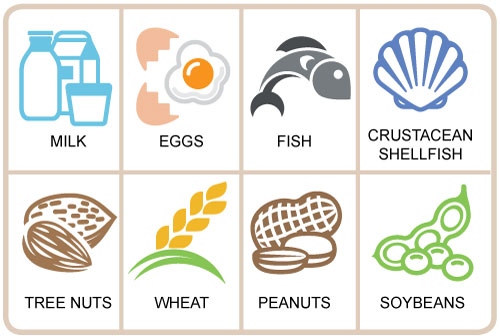Allergenic foods are basically foods that are known to cause food allergies in certain individuals. A food allergy is an immune system response to the presence of specific food types. It is different from food intolerance, which is a digestive system response (e.g. what happens when your child’s body has difficulty digesting food).
There are eight major types of allergenic foods, namely:
Recognising food allergy
In general, the symptoms associated with food allergies can be difficult to connect to specific foods. Typical allergy symptoms include:
- Mouth feels tingly or itchy
- Coughing or wheezing
- Hives
- Abdominal cramps
- Swelling of the throat and vocal cords
- Flushed skin or rash
- Face, tongue, or lip swelling
- Vomiting and/or diarrhoea
- Dizziness and/or light-headedness
- Difficulty breathing
- Loss of consciousness
Since young children may not know how to adequately describe the symptoms, they may say things like “My mouth feels tingly” or “My tongue feels heavy/numb”. The key is to stay alert for any signs of distress which could indicate an allergic reaction.
While food allergies can be serious, there are steps you can take to manage this condition. Once food allergy is suspected, a diagnostic test should be done to complement the clinical history. This is done via a skin prick test or a blood test.
Take note when shopping
If your child is allergic to any specific food, it is best to avoid exposure to those specific foods, especially if he has a severe reaction to them. Pay more attention to the ingredients list when you go grocery shopping.
Major allergenic foods may be listed clearly, e.g. “lecithin (soy),” “flour (wheat),” and “whey (milk)”. Some manufacturers may use a statement on the packaging stating that their product contains certain ingredients, e.g. Contains Wheat, Milk, and Soy. There are also some manufacturers who list allergenic foods as “binder” or “emulsifiers”, which could signal the presence of eggs or soy respectively.
Did you know?
Food allergies often cause symptoms within two hours of ingestion, with some reactions happening within minutes. However, there are very rare cases where the reaction is delayed by up to six hours or more.
There is another type of food allergy with delayed reactions known as Food Protein-Induced Enterocolitis Syndrome (FPIES). This is a severe gastrointestinal reaction which usually happens between 2-6 hours after consuming milk, soy, certain grains or certain solid foods. It typically occurs in young infants exposed to these foods for the first time. FPIES can lead to episodes of repetitive vomiting, which in turn can lead to dehydration. Some babies will even develop bloody diarrhoea.
Handling food allergy
Once you have ascertained that your child has a food allergy, the best thing that can be done is to avoid the food in question, especially if he exhibits a severe reaction. Do note that if he has an allergy to a specific food, he may also be allergic to other related foods, e.g. one who is allergic to shrimp may also be allergic to crab.
If you only suspect that your child has a food allergy, you should keep a food diary. Be sure to list everything that you feed him, and keep the labels of any commercial products as well. This will be a great help in assisting your paediatrician or allergist in determining if he is indeed allergic to any foods.
Your child’s paediatrician or allergist will take any family and medical history necessary and any relevant tests to determine if a food allergy exists.
Away from home
If you do discover that your child has a severe reaction to certain foods, be sure to inform his school and his caregivers about his condition. It may be helpful to provide them with an emergency card detailing how to prevent, recognise and manage his food allergies.
An educational contribution by Malaysian Paediatric Association.









Comments